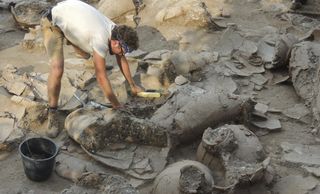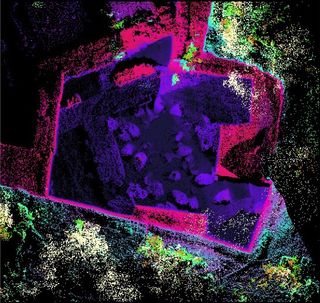In Images: An Ancient Palace Wine Cellar
Ancient Wine Storage

A team of archaeologists discovered this storage room while excavating the site of Tel Kabri in northern Israel. The room measured approximately 15-by-25 feet, and held 40 wine jars that were 3,700 years old.
Wine Jars

These 3,700-year-old jars were discovered in an ancient palatial wine cellar unearthed by researchers at Tel Kabri in July 2013. The team worked in day and night shifts to excavate a total of 40 intact vessels during its six-week dig.
Excavating Jars

Zach Dunseth, a graduate of George Washington University, removes dirt and debris from ancient wine jars while excavating the ruins of a Canaanite city that dates back to approximately 1700 B.C. The group discovered two doors leading out of the wine cellar—both probably lead to additional storage rooms.
Aerial View

An aerial view of Tel Kabri, a 75-acre site in northern Israel that houses the ruins of a Canaanite city dating back to approximately 1700 B.C. Field assistants spell out a whimsical "Kabri" with their bodies near the spot where they discovered a stocked ancient wine cellar.
LIDAR Archaeology

This image of the Tel Kabri wine cellar was created using LIDAR, a technique that uses a pulsed laser to measure distances and generate an accurate 3D map of a location. LIDAR helped the archaeologists map the storage room and each of the 40 wine jars discovered in July 2013.
Sign up for the Live Science daily newsletter now
Get the world’s most fascinating discoveries delivered straight to your inbox.

Stephanie Pappas is a contributing writer for Live Science, covering topics ranging from geoscience to archaeology to the human brain and behavior. She was previously a senior writer for Live Science but is now a freelancer based in Denver, Colorado, and regularly contributes to Scientific American and The Monitor, the monthly magazine of the American Psychological Association. Stephanie received a bachelor's degree in psychology from the University of South Carolina and a graduate certificate in science communication from the University of California, Santa Cruz.
